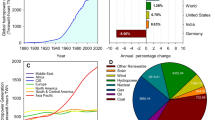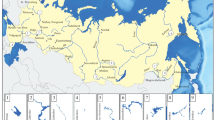Abstract
Several studies over the last decade have shown that tropical reservoirs may constitute an appreciable source of methane (CH4) to the atmosphere. Here, we show that the use of low-cost, innovative mitigation and recovery strategies is able not only to reduce these emissions, but also to transform existing biogenic methane stocks into a renewable energy source. Recovered gas may be pumped to large consuming centers or stored locally and burned by gas turbines to generate electricity during high-demand periods, or even purified for transport applications. Our analysis shows that the use of biogenic methane may increase considerably the energy supply in countries, like Brazil, which possess large tropical reservoirs.
Similar content being viewed by others
References
Abril G, Guérin F, Richard S, Delmas R, Galy-Lacaux C, Gosse P, Tremblay A, Varfalvy L, Dos Santos MA, Matvienko B (2005) Carbon dioxide and methane emissions and the carbon budget of a 10-year old tropical reservoir (Petit Saut, French Guiana). Glob Biogeochem Cycles 19:GB4007. doi:10.1029/2005GB002457
Bambace LAW, Ramos FM, Lima IBT, Rosa RR (2007) Mitigation and recovery of methane emissions from tropical hydroelectric dams. Energy 32:1038–1046
Brazil Agência Nacional de Energia Elétrica (ANEEL) (2005) Atlas de energia elétrica do Brasil (2a edição). Brasília, Brazil
Cicerone RJ, Oremland RS (1988) Biogeochemical aspects of atmospheric methane. Glob Biogeochem Cycles 2:299–327
Delmas R, Richard S, Guérin F, Abril G, Galy-Lacaux C, Delon C, Grégoire A (2004) Long term greenhouse gas emissions from the hydroelectric reservoir of Petit Saut (French Guiana) and potential impacts. In: Tremblay A, Varfalvy L, Roehm C, Garneau M (eds) Greenhouse gas emissions: fluxes and processes. Hydroelectric reservoirs and natural environments, Environmental Science Series. Springer, New York, pp 293–312
dos Santos MA, Rosa LP, Sikar B, Sikar E, dos Santos EO (2006) Gross greenhouse gas fluxes from hydro-power reservoir compared to thermo-power plants. Energy Policy 34:481–488
Duchemin E, Lucotte M, Canuel R, Chamberland A (1995) Production of the greenhouse gases CH4 and CO2 by hydroelectric reservoirs of the Boreal region. Glob Biogeochem Cycles 9(4):529–540
Duchemin E, Lucotte M, Queiroz AG, Canuel R, da Silva HCP, Almeida DC, Dezincourt J, Ribeiro LE (2000) Greenhouse gas emissions from an old tropical reservoir in Amazonia: Curuá-Una reservoir. Verh Internat Verein Limnol 27:1391–1395
Fearnside PM (1995) Hydroelectric dams in the Brazilian Amazon as sources of greenhouse gases. Environ Conserv 22:7–19
Fearnside PM (1997) Greenhouse-gas emissions from Amazonian hydroelectric reservoirs: the example of Brazil’s Tucuruí dam as compared to fossil fuel alternatives. Environ Conserv 24:64–75
Fearnside PM (2002) Greenhouse gas emissions from a hydroelectric reservoir (Brazil’s Tucuruí dam) and the energy policy implications. Water Air Soil Pollut 133:69–96
Fearnside PM (2004) Greenhouse gas emissions from hydroelectric dams: controversies provide a springboard for rethinking a supposedly clean energy source. An editorial comment. Clim Change 66:1–8
Fearnside PM (2005a) In: Sevá Filho AO (ed) Tenotã-mõ: alertas sobre as conseqüências dos projetos hidrelétricos no rio Xingu, Pará, Brasil, International Rivers Network, São Paulo, Brazil, 2005. pp 204–241. http://www.irn.org/programs/latamerica/pdf/TenotaMo.pdf
Fearnside PM (2005b) Do hydroelectric dams mitigate global warming? The case of Brazil’s Curuá-Una dam. Mitig Adapt Strategies Glob Chang 10(4):675–691
Fearnside PM (2005c) Brazil’s Samuel dam: lessons for hydroelectric development policy and the environment in Amazonia. Environ Manage 35(1):1–19
Fearnside PM (2006) Dams in the Amazon: Belo Monte and Brazil’s hydroelectric development of the Xingu river basin. Environ Manage 38(1):16–27
Fearnside PM (2008) Hidrelétricas como ‘fábricas de metano’: O papel dos reservatórios em áreas de floresta tropical na emissão de gases de efeito estufa. Oecologia Brasiliensis 12:100–115
Forster P, 50 others (2007) Changes in atmospheric constituents and radiative forcing. In: Solomon S, Qin D, Manning M, Chen Z, Marquis M, Averyt KB, Tignor M, Miller HL (eds) Climate change 2007: the physical science basis. Contribution of working group to the fourth assessment report of the intergovernmental panel on climate change. Cambridge University Press, Cambridge, pp 129–234
Galy-Lacaux C, Delmas R, Jambert C, Dumestre J-F, Labroue L, Richard S, Gosse P (1997) Gaseous emissions and oxygen consumption in hydroelectric dams: a case study in French Guyana. Glob Biogeochem Cycles 11:471–483
Guérin F, Abril G (2007) Significance of pelagic aerobic methane oxidation in the methane and carbon budget of a tropical reservoir. J Geophys Res 112:G03006
Guérin F, Abril G, Richard S, Burban B, Reynouard C, Seyler P, Delmas R (2006) Methane and carbon dioxide emissions from tropical reservoirs: significance of downstream rivers. Geophys Res Lett 33:L21407
Joyce J, Jewell PW (2003) Physical controls on methane ebullition from reservoirs and lakes. Environ Eng Geosci 9:167–178
Keller M, Stallard RF (1994) Methane emission by bubbling from Gatun Lake, Panama. J Geophys Res (Atmos.) 99(D4):8307–8319
Kemenes A, Forsberg BR, Melack JM (2007) Gas release below a tropical hydroelectric dam. Geophys Res Lett 34(12):L12809
Kling GW, Evans WC, Tanyileke G, Kusakabe M, Ohba T, Yoshida Y, Hell JV (2005) Degassing Lakes Nyos and Monoun: defusing certain disaster. Proc Natl Acad Sci U S A 102(40):14185–14190
Lima IBT (2005) Biogeochemical distinction of methane releases from two Amazon hydroreservoirs. Chemosphere 59:1697–1702
Lima IBT, ENovo MLM, Ballester MV, Ometto JP (1998) Methane production, transport and emission in Amazon hydroelectric plants. In: IEEE IGARSS’98 international geoscience and remote sensing symposium, Seattle, proceedings, pp 2529–2531
Lima IBT, Ramos FM, Bambace LAW, Rosa RR (2008) Methane emissions from large dams as renewable energy resources: a developing nation perspective. Mitig Adapt Strategies Glob Change 13:193–206
Melack JM, Hess LL, Gastil M, Forsberg BR, Hamilton SK, Lima IBT, Novo EMLM (2004) Regionalization of methane emissions in the Amazon Basin with microwave remote sensing. Glob Chang Biol 10:530–544
Muresan B, Cossa D, Richard S, Dominique Y (2008) Monomethylmercury sources in a tropical artificial reservoir. Appl Geochem 23:1101–1126
Novo ELM, Tundisi JG (1994) Contribution of remote sensing techniques to the assessment of methane emission from large tropical reservoirs. Remote Sens Rev 10:143–153
Nozhevnikova AN, Holliger C, Ammann A, Zehnder AJB (1997) Methanogenesis in sediments from deep lakes at different temperatures (12–70 degrees C). Water Sci Technol 36:57–64
Pacca S (2007) Impacts from decommissioning of hydroelectric dams: a life cycle perspective. Clim Change 84:281–294
Ramos FM, Lima IBT, Rosa RR, Mazzi EA, Carvalho JC, Rasera MFFL, Ometto JPHB, Assireu AT, Stech JL (2006) Extreme event dynamics in methane ebullition fluxes from tropical reservoirs. Geophys Res Lett 33:L21404
Rosa LP, dos Santos MA (2000) Certainty and uncertainty in the science of greenhouse gas emissions from hydroelectric reservoirs (part II) World Commission on Dams, Cape Town, South Africa, 2000. http://www.dams.org/docs/kbase/thematic/tr22pt2.pdf
Schimel D, 75 others (1996) Radiative forcing of climate change. In Houghton JT, Meira Filho LG, Callander BA, Harris N, Kattenberg A, Maskell K (eds) Climate change 1995: the science of climate change. Cambridge University Press, Cambridge, pp 65–131
St Louis VL, Kelly CA, Duchemin E, Rudd JWM, Rosenberg DM (2000) Reservoir surfaces as sources of greenhouse gases to the atmosphere: a global estimate. Bioscience 50:766–775
Whalen SC (2005) Biogeochemistry of methane exchange between natural wetlands and the atmosphere. Environ Eng Sci 22:73–94
Author information
Authors and Affiliations
Corresponding author
Rights and permissions
About this article
Cite this article
Ramos, F.M., Bambace, L.A.W., Lima, I.B.T. et al. Methane stocks in tropical hydropower reservoirs as a potential energy source. Climatic Change 93, 1–13 (2009). https://doi.org/10.1007/s10584-008-9542-6
Received:
Accepted:
Published:
Issue Date:
DOI: https://doi.org/10.1007/s10584-008-9542-6




